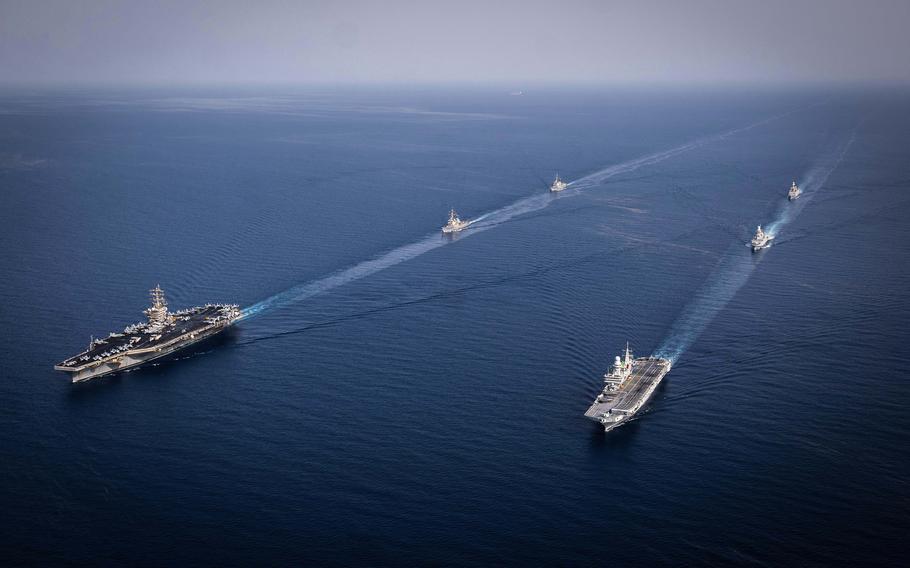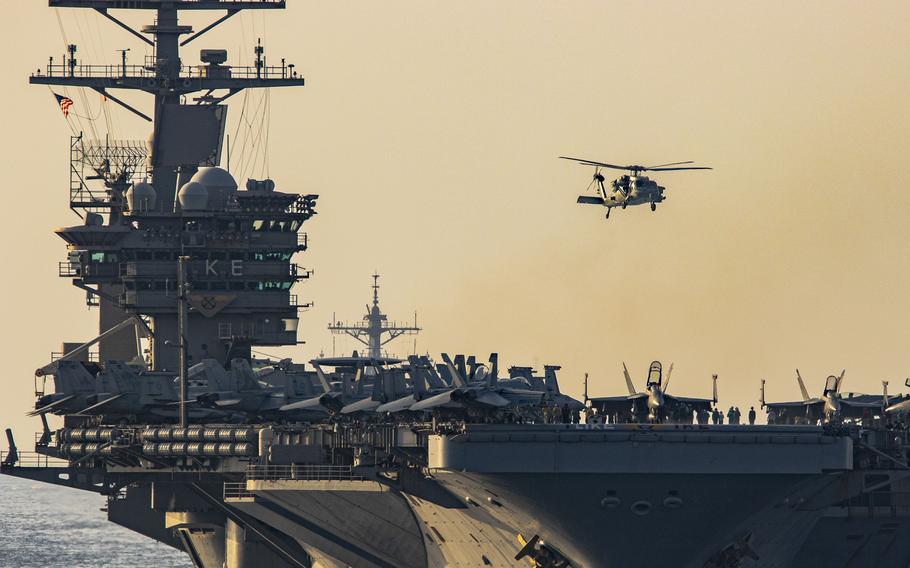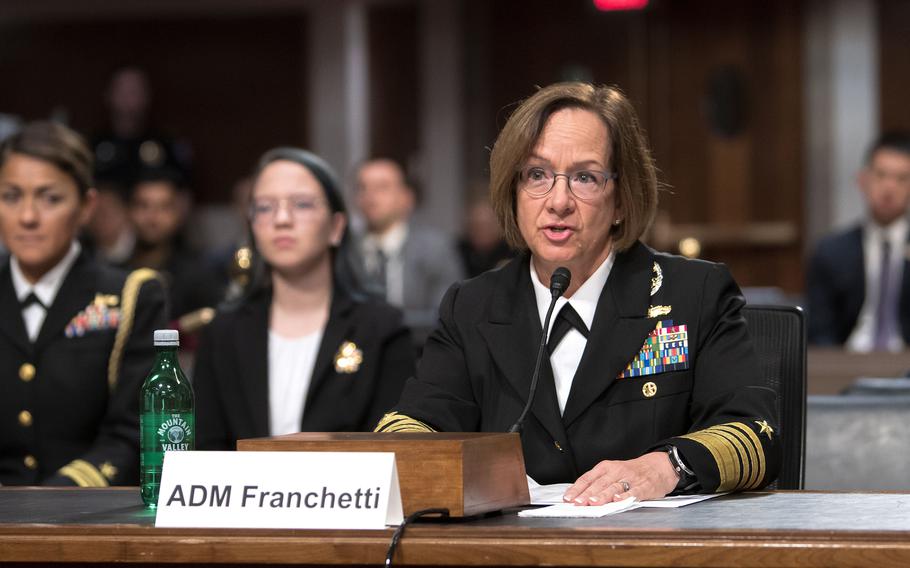
The USS Dwight D. Eisenhower carrier strike group steams in formation with the Italian navy ships in the Red Sea in June 2024. (Courtesy photo from Italian navy)
WASHINGTON — Tackling delays in ship maintenance, using more drones, and improving recruiting are part of the Navy’s plan to prepare the fleet in three years for a potential fight with China, the chief of naval operations announced Wednesday in a new initiative called “Project 33.”
“The chairman of the People’s Republic of China has told his forces to be ready for war by 2027 — we will be more ready,” said Adm. Lisa Franchetti, the sea service’s top officer.
Project 33 was wrapped into the 2024 Navigation Plan, a framework of Franchetti’s priorities during her tenure as chief of naval operations. The plan identified seven areas of focus that fall under Project 33, including eliminating delays in ship maintenance, integrating more drones and autonomous systems into the force, and building upon existing quality-of-service initiatives to recruit and retain the sailors needed to man warfighting ships.
The 30-page plan, which Franchetti described as ambitious but necessary, sets a goal to implement all seven priority areas by 2027.
“Project 33 sets new targets but we do not need new levers to reach them. This is core to my guidance. We will deliver results using the tools and resources we have to gain ground without losing speed,” she said.
A key is to have 80% of the force ready enough at any given time to deploy for combat if needed. The Navy is structured to have one-third of the fleet in maintenance, one-third in training and one-third on or ready for deployment. But maintenance delays could mean ships are not ready for a fight.
“We must accelerate our efforts to deliver the ready force we need now. We must do so to deter potential adversaries and be ready when called,” Franchetti said.
Driving Franchetti’s Project 33 are the tensions and wars around the globe now. The plan notes while Russia is “wounded and isolated” following its invasion of Ukraine, the country remains dangerous. And nefarious networks between Iran and Russia amid relentless attacks on merchant shipping in the Middle East make peace brittle.

Components of the USS Dwight D. Eisenhower carrier strike group and a French navy ship transited the Strait of Hormuz in November 2023. (Daniel Goodin/U.S. Navy)
“The pace of war is accelerating. What that means for our warfighting ecosystem is something we are actively learning,” Franchetti said.
Drawing on lessons from fleet experimentation and real-world developments in the Black and Red seas, Franchetti said the Navy must deliver a proven hybrid fleet that incorporates robotic and drone capabilities by 2027.
The Ukrainian navy used a combination of missiles, robotic surface vessels, and agile digital capabilities to deny the Russian navy use of the western Black Sea and threaten Russia’s supply lines to occupying forces in Crimea.
For months in the Red Sea, aircraft carrier strike groups and amphibious groups have battled Iran-backed Houthi rebels launching drone and missile attacks from Yemen that threaten maritime merchant shipping.
“We have seen breakthroughs in battlefield innovation over the last two years, with profound implications for the changing character of war. Cheaper, more accessible technology is pushing asymmetric capability, at lower cost, to state and nonstate actors alike,” Franchetti said.
In response, the Navy established an enlisted robotics warfare specialist rating this year and the service is exploring how to grow robotics expertise in the officer ranks. The Navy has also moved from experimentation to integrating robotic and autonomous systems across the fleet and the service’s special warfare forces are pushing to test new systems to counter drones, according to Franchetti.
“As chairman of the Joint Chiefs, Gen. “CQ” Brown says, ‘accelerate change or lose,’ and we have no intention of losing,” she said.
The Navy is also working to fill all active-duty and reserve forces ratings and staff deploying units to 95%. In line with this effort, the service aims to reach 100% of recruiting goals and fill the delayed entry program to 50%.
This effort is already gaining traction. The Navy Recruiting Command reported in August that it was on track to surge the force by 40,000 sailors and meet the 2024 recruiting goal after years of shortfalls that forced the service to empty its delayed-entry pool of troops.
The service is also working to eliminate involuntary living aboard ships in homeport and ensure no first-term sailor is forced to spend more than two years assigned to a ship undergoing an extended modernization period. Allowing sailors to escape lengthy tours in a shipyard furthers quality-of-life initiatives launched in recent years following clusters of sailor suicides across the country.
“Given the competitive recruiting environment we face, we cannot afford to have a single sailor leave our Navy because we failed to provide for them,” Franchetti said.

Adm. Lisa Franchetti, the chief of naval operations, testifies in September 2023 at a Senate Armed Services Committee hearing on Capitol Hill in Washington. (Stars and Stripes)
Beyond Project 33, the 2024 Navigation Plan builds on the previous plan from 2022 to push Congress for continued investments in the industrial base and capability modernization. The Navy has tried to balance its budget by divesting in older ships to invest in procuring new more capable ships — something lawmakers have challenged as China already has more warships than the United States.
Getting ships out of maintenance on time, while working with Congress to get the resources necessary to support the fleet, is critical to ensuring the Navy can respond to conflict and crises and win decisively in war.
“It will be hard work but if we follow through, we will deliver a Navy that is ready today and postured to achieve overwhelming advantage tomorrow,” Franchetti said.